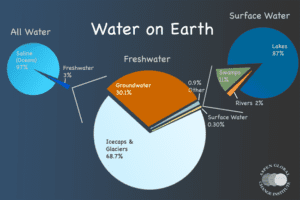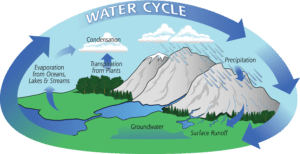Many of us don’t give a thought about where our water comes from and where it goes. Water is all around us, and every living thing needs it to survive. This includes humans, plants, and animals!
Even though about 71% of the Earth’s surface is covered in water, it is still a finite resource. That is because 97% of the water around us is saltwater and only 3% of all water on Earth is freshwater.
Of the freshwater, about 69% of it is locked up in glaciers and ice caps, about 30% of it is underground, and 1% is on the surface including lakes, streams, rivers, etc.

Due to some of the freshwater being polluted or too hard to extract, less than 1% is available for consumption. That leaves only a small amount of freshwater that is available for use, so it is crucial to learn about water conservation and the ways to keep the water clean.
This video demonstrates the above in a visual representation.
The water that is available is found in watersheds (The land area, or catchment, that contributes water to a specific water body. All the rain or snow that falls within this area flows to the water bodies as surface runoff, in tributary streams, or as groundwater) in our environment. A watershed consists of many things. Mountains collect water and bring it to rivers and lakes, then through cities, and finally down to the bays and oceans.
All water is recycled through the water cycle where it moves between different states (gas, liquid, vapor) and throughout the planet’s surface and atmosphere. That means that the water used today has been recycled, and could have been the same water that dinosaurs drank!

For most of Bellingham, the drinking water for about 100,000 residents comes from Lake Whatcom. Water flows to Lake Whatcom from two main sources: rainwater in the Lake Whatcom watershed and water from the Deming Glacier. Once the water is treated at the water treatment plant, and is then used, it flows to the wastewater treatment plant where it is cleaned again, then put into Bellingham Bay through a series of pipelines. Below are the steps water takes to get to the treatment plant where it will be filtered and clean for us to use:
- Rainwater falls into the Lake Whatcom watershed and water from the Deming Glacier on Mt.Baker flows to the Middle Fork of the Nooksack River and is seasonally diverted into Lake Whatcom through a tunnel under Bowman Mountain.
- The city then withdraws water from Basin 2 in Lake Whatcom through a 1200-foot wooden pipeline and sends it to the screen house located at Whatcom Falls Park. At the screen house, the large debris and fish are removed, and then chlorine gets added.
- After the water travels through the screen house, a pipeline conveys the water to the Water Treatment Plant, also located near Whatcom Falls Park.
- At the Water Treatment Plant, the water is sent through different pipes, and goes through different stages to ensure the water is clean for us to drink and use. You can read about these steps in more detail on the City of Bellingham’s site.
- After the water is clean, it goes through more pipes and eventually to the pipes connected to your home.
Conserve
There are many ways that we can conserve or save water at home and at school. Some examples include:
- Turning off the faucet when brushing your teeth or washing your face
- Taking shorter showers
- Capturing rainwater in a rain barrel to then use to water your plants
- Giving your unused water to your pets or plants
- Only washing FULL loads of laundry or dishes
- Check for leaks
Can you think of some?
